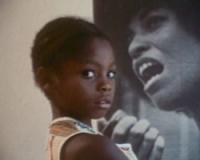For years, the name Carroll Parrott Blue has been associated with innovative media and storytelling. Finally, during last week’s screening, we were able to see her pioneering creative mind at work.
During the first few frames of the piece The Dawn at My Back: a Memoir of a Black Texas Upbringing, it was clear that the film was being crafted by the methodical mind of a sensitive master at work. In Dawn, Blue approached story in a non-linear way and the effect was breathtaking. Like the intricate work a quilt maker must perform to assemble scraps of fabric as one cohesive piece of art, Blue similarly crafted. The quilting she did read as blended rather than a pastiche, which is hard to do with such disparate parts making up a whole.
Part of the reason the parts functioned as a whole was the deliberately interactive style of the piece. Blue spoke of the extensive work she did in collaboration with Kristy H.A. Kang. Through their collaboration, they created and achieved a visual space that took the viewer on this patchwork journey. The viewer was conscious of when the director was moving from one memory to the next primarily because of an arrow that moved to and then hovered above the thumbnail of the next story to be selected. When the thumbnail was clicked, the world behind the still image was animated.

Blue and Kang quilted important stories from Blue’s hometown together that were not necessarily directly related to things she or her mother experienced. Still, these events were vivid memories of occurrences that certainly impacted the fabric of the small town Texas society. The effect of including other stories in the nest of her's was universalizing. Although Dawn was about Blue as a continuum with her mother, the particular stories the filmmaker juxtaposed showed that occurrences that are not directly related to a person, could still impact their psychology. This was reminiscent of the butterfly effect. She seems to highlight the interdependence of all stories.
In the Q&A after the film, Carroll Blue called her film a “database narrative.” While Blue’s work is part of a new genre of filmic device and storytelling, the database narrative is something that has come of age within the last few years. Marsha Kinder does not see the two as working against each other. She states that the “database and narrative [are] two compatible structures whose combination is crucial to the creative expansion of new media since all narratives are constructed by selecting items from databases…and then combining these items to create a particular story.” This is particularly relevant in the case of Carroll Blue’s work.
If you look at The Dawn at My Back: a Memoir of a Black Texas Upbringing, the visuals work in complete synergy with the technology to formulate a new kind of cinema; one that not only implicates and enhances the viewer’s cinematic experience, but also causes them to reflect upon their own unique space, due to the fact that they are interacting with the piece. When we watch Carroll’s mother’s face slowly morph into her own, we are dreamily led into a place that is as real as the stories she tells. It is slow, but effective. The trick is that Carroll/Carroll’s mother is looking at us, which compels us even more intensely into the full narrative. Even if this were not as interactive a piece as it is, the transition/breaking of the fourth wall alone would be enough to cement the audience into willing complicity for a full experience.
Sitting in a theater is quite often an experience of fictional engagement. With Carroll Parrott Blue, not only is this not the case, but she causes the audience to personally put into action Jean Cocteau’s quote: “the mirror would do well to reflect further.” Dawn is an interactive non-fiction piece and it is based upon ideas of personal history and a larger cultural history. Watching the arrow click from space to space and place to place, this kind of “digital storytelling” is something that appeals to many of us due to the high-tech world we live in. The truly amazing part of Blue’s work is the dimension of emotionality that she is able to put at the core of this new media project.
In an email interview with the filmmaker, she stated that for her, “content is the brain, spine and heart of narrative. One of the lessons I learned while at UCLA Film School was that content trumps aesthetics every day. So I employ beauty to deliver content. Another axiom of mine is that the more individual the personal, the more universal the message. What is personal about my story caused you to reflect on your own story.” Her ideas of beauty, content and universality within the context of new media methodology have produced something that truly should be experienced. The fact that she could take such a personal story and make it applicable to an entire room of people with a multiplicity of different backgrounds speaks to her aesthetic principles and their success.
Placing personal historical assets within a filmic work of art that can be both seen and interacted with is groundbreaking and revolutionary. Not only does it envision things for this new world of the “database narrative” artform but it clearly can look towards ways of archiving in general. Carroll Parrott Blue’s work is definitely something to keep an eye on.
—Iyabo Kwayana and Ariel Schudson






 Mobile Navigation
Mobile Navigation


Comments